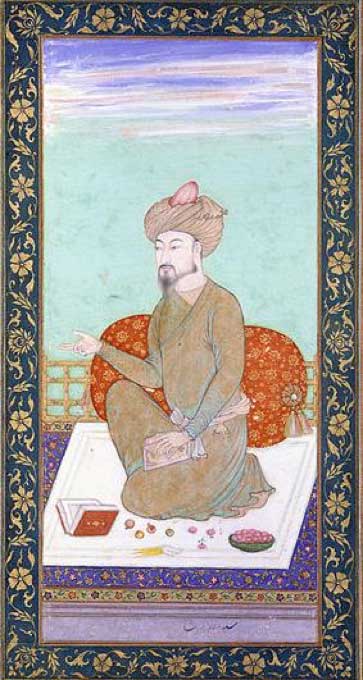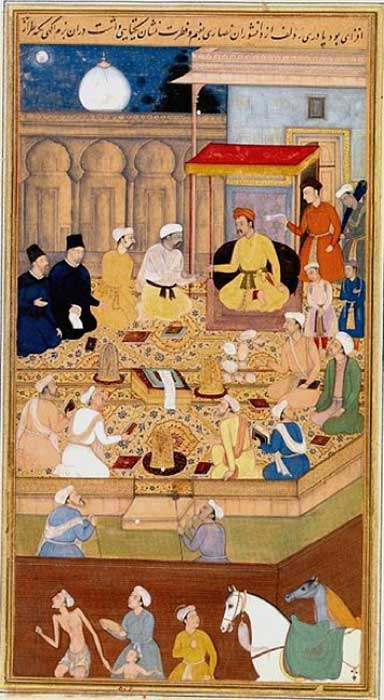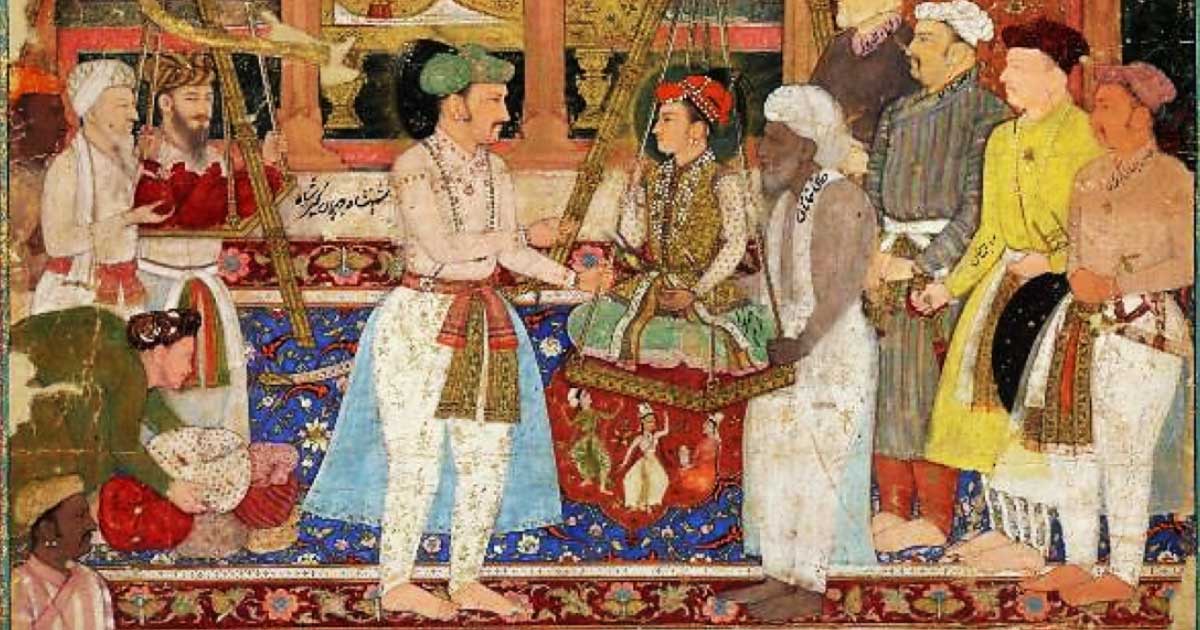The Mughal Empire: Tolerance, Taxes, Addiction, Art, and Other Acts of Genghis Khan’s Relatives in India
Mongols, Mughals, are they the same? No, but there is a link between the Medieval / Early Modern empire that ruled over large parts of the Indian subcontinent and the powerful Khan force that hailed from Mongolia. But the Mughal dynasty is not only well-known for its relation to Genghis; its existence also helps explain how Islam became such a prominent religion in India.
The rulers of the Mughal (sometimes transliterated as Mogul) dynasty trace their roots to both Genghis Khan (through his second son, Chagatai Khan), and Timur. The invasion of the Indian subcontinent by Babur, the founder of the Mughal Empire, was inspired by stories of the latter’s exploits. The Mughal Empire ended around the middle of the 19th century, though its decline had already begun a century and a half earlier.

Portrait of Mughal Emperor Zahir ud-Din Mohammad (Babur). (Public Domain)
The Beginning of the Mughal Empire
In 1526, Ibrahim Lodi, the last Lodi ruler of the Delhi Sultanate, was defeated by Babur at the First Battle of Panipat, thus marking the beginning of the Mughal Empire. Although Babur was born in Ferghana (in modern day Uzbekistan), it was the accomplishments of direct ancestor, Timur, that inspired him to head south to invade the Indian subcontinent. The years between the victory at Panipat and Babur’s death in 1530 were marked by constant warfare between the fledgling Mughal Empire and the various rulers of northern India.
- Mahmud of Ghazni: Merciless Tyrant Obliterated Hindu Temples and Conquered Territories Through Plunder and Slaughter
- Timurid Empire’s Arts and Culture Influenced Much of the Known World
- Jauhar - The History of Collective Self Immolation during War in India

Mughal musket and siege. (CC BY SA 4.0)
Although Babur emerged victorious from the battles against these rulers, he did not have sufficient time to consolidate his gains, and the task was left to his son and successor, Humayun. Humayun was not as capable as his father and he was deposed and sent into exile in 1540 by Sher Shah Suri. Between 1540 and 1555, the Mughal Empire was replaced by the Suri Empire; it was only restored with the aid of the Safavid Persians. Humayan died not long after the Mughal Empire was restored, as a result of a fall from a flight of stone stairs. Nevertheless, during this short period, he was able to extend the borders of the empire.
The Mughal Empire Under Akbar
Humayun was succeeded by his 13-year-old son, Jalal-ud-Din Akbar, and the task of keeping the empire together seemed almost impossible. Fortunately for the dynasty, Akbar was aided during his regency by a capable chief minister, Bairam Khan. When the boy was old enough to rule on his own, he proved to be a formidable ruler, eventually becoming known as ‘Akbar the Great’.
Akbar ruled the Mughals until 1605, and his reign was the beginning of the Mogul Golden Age. Apart from extending the borders of the Mughal Empire, Akbar is also remembered for his abilities as an administrator. As an example, revenues were fixed according to local conventions of cultivation and soil quality, and were paid in cash. This ensured that the empire could reap the maximum profit without placing too heavy a burden on the people. Additionally, Akbar sought to assimilate his Muslim and Hindu subjects. For instance, he promoted religious tolerance, and encouraged intermarriage between the Mughal and Rajput aristocracy.

Mughal Emperor Akbar (r. 1556-1605) holds a religious assembly in the Ibadat Khana (House of Worship) in Fatehpur Sikri; the two men dressed in black are the Jesuit missionaries Rodolfo Acquaviva and Francisco Henriques. (Public Domain)
Art and Architectural Achievements of the Mughal Empire
The Mughal Empire continued to prosper under the next three emperors – Jahangir, Shah Jahan, and Aurangzeb. The stability of the empire during this period could be seen, for example, in the fact that although Jahangir was addicted to alcohol and opium, he was able to rule over the empire for 22 years without much fear of upheavals.
Great artistic works were also created during this time. Arguably the best-known monument in India, the Taj Mahal, was built by Shah Jahan as a mausoleum for his beloved wife, Mumtaz Mahal. The last of the great Mughals was Aurangzeb, who reigned from 1658 to 1707. During his reign, the Mughal Empire reached its largest territorial extent. This, however, also left the empire in a weaker state. Moreover, internal and external problems began to surface, signaling the beginning of the end for the Mughals.
- The Delhi Sultanate: 300 Years of Muslim Power Over the Indian Subcontinent
- The Diwali Festival of Lights: A Celebration of Freedom and Good Triumphing over Evil
- Shah Jahan: Creator of the Taj Mahal and One of the Most Powerful Mughal Emperors

Taj Mahal. (Yann Forget/CC BY SA 3.0)
The Decline of the Mughal Empire
In the 58 years that followed after the death of Aurangzeb, the Mughal Empire had eight emperors, four of whom were murdered, and one deposed. Whilst the Mughals had a large army, their weapons and tactics were outdated, rendering them less efficient than they had been. Regional governors took the opportunity to declare their independence, whilst external enemies, including the Persians and Afghans, succeeded in invading Delhi. By the middle of the 19th century, much of the Mughal Empire had fallen into the hands of the British.
The last Mughal emperor, Bahadur Shah Zafar, was an emperor only in name. As a result of his involvement in the Indian Rebellion of 1857, he was tried, found guilty, and exiled to Rangoon (now known as Yangon), in Burma, where he died in 1862.

Two elephants carrying the fish and sun insignia of Mughal sovereignty. (Public Domain)
Top Image: Detail of Mughal Emperor Jahangir weighing Prince Khurram (later crowned Shah Jahan of the Mughal Empire). Page from Tuzk-e-Jahangiri. 1610-1615, British Museum, London. Source: Public Domain
By Wu Mingren
References
knowindia.gov.in, 2018. The Mughal Empire. Available at: http://knowindia.gov.in/culture-and-heritage/medieval-history/the-mughal-empire.php
New World Encyclopedia, 2016. Mughal Empire. Available at: http://www.newworldencyclopedia.org/entry/Mughal_Empire
Samson, I., 2011. Great dynasties of the world: The Mughals. Available at: https://www.theguardian.com/lifeandstyle/2011/jul/16/great-dynasties-mughals-ian-sansom
Szczepanski, K., 2018. The Mughal Empire in India. Available at: https://www.thoughtco.com/the-mughal-empire-in-india-195498
The Editors of Encyclopaedia Britannica, 2018. The Mughal Empire, 1526–1761. Available at: https://www.britannica.com/place/India/The-Mughal-Empire-1526-1761
Victoria and Albert Museum, 2018. The Age of the Mughals. Available at: http://www.vam.ac.uk/content/articles/a/the-age-of-the-mughals/
www.historyworld.net, 2018. History of the Moghul Empire. Available at: http://www.historyworld.net/wrldhis/PlainTextHistories.asp?historyid=ab99

















